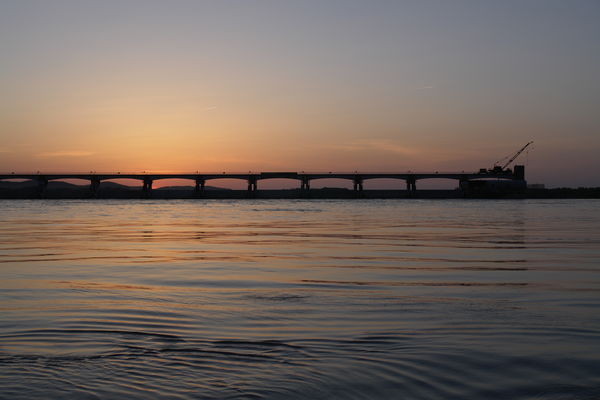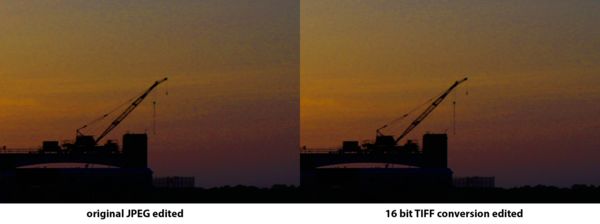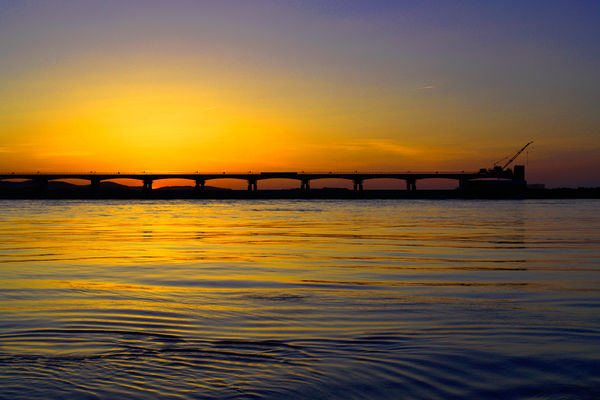JPEG FLAT setting in Nikon D7500
Jul 19, 2021 21:40:06 #
Ysarex
Loc: St. Louis
selmslie wrote:
Not at all.
We are looking for evidence that editing the TIFF is no better than editing the JPEG. You cannot provide that.
We are looking for evidence that editing the TIFF is no better than editing the JPEG. You cannot provide that.
I did provide that -- twice now: https://www.uglyhedgehog.com/t-704864-2.html#12408265
https://www.uglyhedgehog.com/t-704864-2.html#12408844
The same editing degradation occurs to both files equally. Your evidence?
Jul 20, 2021 00:09:58 #
Ysarex wrote:
I did provide that -- twice now: https://www.uglyhedgehog.com/t-704864-2.html#12408265
https://www.uglyhedgehog.com/t-704864-2.html#12408844
The same editing degradation occurs to both files equally. Your evidence?
https://www.uglyhedgehog.com/t-704864-2.html#12408844
The same editing degradation occurs to both files equally. Your evidence?
Your “evidence” is not credible.
Jul 20, 2021 02:37:49 #
Ysarex
Loc: St. Louis
selmslie wrote:
Your “evidence” is not credible.
Refute it. With.... Oh yeah, you have no evidence. You just have BS and bupkis. I mean you could have at least done some graphs or charts or something. How about a good graph to make you look all engineery and stuff.
While we wait let's go ahead and do another example. First photo below is the JPEG. What JPEG shooter could resist enhancing a sunset? So I loaded the JPEG into PS and duplicated it. I converted the duplicate to a 16 bit TIFF and then edited the JPEG. I literally dragged the adjustment layers from the JPEG to the 16 bit TIFF -- editing is identical between the two files.
Both full-res images are below and both show considerable banding and degradation in the sky. There's no point in even identifying which is which but for the record the first image is the edited 16 bit TIFF and the last image is the edited JPEG.
Now if you want to prove that converting to 16 bit before editing prevents the degradation that occurs when an 8 bit JPEG is edited, download the JPEG and prove it.
Jul 20, 2021 06:02:06 #
Ysarex wrote:
Refute it. With.... Oh yeah, you have no evidence. You just have BS and bupkis. ....
I understand how this works because the mathematical models I have worked with are either 32-bit integer (-2147483648 through 2147483647) or 64-bit floating point (-9.223372037E18 through 9.223372037E18).
Here is a brief lesson in binary and integer math.
As you know, a JPEG can represent the range of tones from black to white as 0-255, 256 integer values. A 16-bit TIFF represents the same range as 0-65535, 65536 integer values - much more precision.
The raw file and the image files store the values as binary data (0 and 1) or integer values. They don't save decimal values. Here is what they look like:
8-bit 16-bit
decimal 64 16384
bin 01000000 0100000000000000
decimal 32 8192
bin 00100000 0010000000000000
decimal 64.448 16498.688 (0.7% increase)
integer 64 16499
bin 01000000 0100000001110011
decimal 32.48 8314.88 (1.5% increase)
integer 32 8315
bin 00100000 0010000001111011
So it is very likely that, if you make a small change in contrast or tonality, banding will show up in a JPEG but not in a 16-bit TIFF simply because the values are rounded to integers. A JPEG cannot represent the small change in tonality that the 16-bit TIFF can handle routinely.
You have probably been looking in the wrong place. Banding shows up sooner in the darker tones. You may not see it in the lighter tones until you have made multiple adjustments and saves.
If you can't take this in then you are not qualified to compare a JPEG to a 16-bit TIFF.
Jul 20, 2021 07:25:02 #
billnikon
Loc: Pennsylvania/Ohio/Florida/Maui/Oregon/Vermont
quixdraw wrote:
Here is an explanation of the Picture Controls direct from Nikon. https://www.nikonusa.com/en/learn-and-explore/a/tips-and-techniques/picture-controls-step-by-step.html
I do not care to use Raw and still get quite satisfactory photos.
I do not care to use Raw and still get quite satisfactory photos.
Your quote, "I do not care to use Raw and still get quite satisfactory photos". Was the way I thought a few years ago. I do camera shows and bragged about only using Jpeg and "getting in right in the camera".
On a dare I used RAW for a month. I had always done photoshop so that was not new. So now I started doing RAW in photoshop. Guess what, all the guys who bragged about using RAW over Jpeg were right.
I always took great pictures (not satisfactory) Personally I can not be satisfied with "satisfactory", just in not in my nature. But with RAW I could take a great image and make it much better.
Yes, please continue to do what your doing, you are getting satisfactory images. But if you want to go to the next level, do what I finally did, move up to the RAW level.
Jul 20, 2021 08:11:10 #
larryepage
Loc: North Texas area
billnikon wrote:
Your quote, "I do not care to use Raw and sti... (show quote)
Bill...my history is similar to yours, except that my motivation didn't come from a dare. It came instead from taking on a genre of photography that simply is not possible except via raw files. Since then, I have adopted the beneficial practice of editing the raw versions of other images as well.
Where I differ from many here, however, is that I also take many photographs which, while still important, do not rise to the level of requiring or even deserving time spent in editing. For those photographs, a well-executed JPEG is perfectly fine. So my camera and my habits are always set to capture both...a nice JPEG and a raw file for those that will receive more attention later. And the bonus is that I find that the "finished" JPEGs are extremely helpful in selecting which images for which the raw files will get further work.
Jul 20, 2021 08:31:43 #
CHG_CANON summed it up quite nicely, "No version of JPEG any sort of equivalent of RAW." That's pretty much all you need to know.
Now, there are those who do their initial exposures using jpg and get some commendable results. However, jpg does have some inherent issues due to the mentioned 8bit structure.
--Bob
Now, there are those who do their initial exposures using jpg and get some commendable results. However, jpg does have some inherent issues due to the mentioned 8bit structure.
--Bob
Kleinburg Kid wrote:
Has anyone out there used this setting, which appears to be a JPEG equivalent to RAW? If so, what is your impression of it?
Jul 20, 2021 09:01:39 #
Retina
Loc: Near Charleston,SC
Thomas902 wrote:
Ysarex have you actually tried converting to 16bit?
I have and it works for me... I suggest you actually try it fore claiming something that simply isn't valid...
It's clueless antagonist like you who bring nothing to the dance but their ego and territorial imperative...
Why don't you try and address the OP's query instead?
Or is that below your masterful attainment level....
I have and it works for me... I suggest you actually try it fore claiming something that simply isn't valid...
It's clueless antagonist like you who bring nothing to the dance but their ego and territorial imperative...
Why don't you try and address the OP's query instead?
Or is that below your masterful attainment level....
It seems logical that a one-time conversion to 16 bit and working with it in that depth doesn't add to banding or other artifacts other than what was already there, of course. I do something similar with audio files that start in MP3. I convert to 24 bit/192k first so that all the processing steps, and there can be a lot, is done in a near zero audible artifact domain, and then once back to MP3 at the end. If I didn't work with large bit depth and sample rates I would end up with a mess. Similarly, if I started with a JPEG photo and converted to 16 and worked with it there, it would still, of course, have whatever artifacts were there initially, but it would not be adding more until the final conversion, which should be minimal. A crude analogy is working with old photographs. If they were taken with an Instamatic, does that mean it is a waste to try to work with it them the digital domain with the best hardware and software at hand?
Jul 20, 2021 09:04:30 #
Ysarex
Loc: St. Louis
selmslie wrote:
I understand how this works because the mathematic... (show quote)
So no evidence. That's what I expected.
Jul 20, 2021 09:27:19 #
larryepage wrote:
Bill...my history is similar to yours, except that my motivation didn't come from a dare. It came instead from taking on a genre of photography that simply is not possible except via raw files. Since then, I have adopted the beneficial practice of editing the raw versions of other images as well. ...
It should be no mystery why we prefer to create our images from the raw file. We are starting with luminance information that is 14-bit at the high end and each one stop increment from the brightest exposure zone down to three stops below middle gray all have more than 256 possible integer values.
Of course, having 8000 possible values in the brightest exposure zone is absurdly more than necessary but the point of ETTR is to increase the size of the integer values in the raw file for the darker zones.
This step wedge contains 256 distinct steps with values from 0 to 255.

If you look at a scene with a 10 stop dynamic range, each of those one-stop zones in a JPEG or an 8-bit TIFF can end up being represented by only 25 or 26 distinct integers.
If you look closely, you may already be able to see the edges of some of the steps. If you download it and change the tone curve, add a horizontal gradient, change the contrast, or the brightness of any portion of the step wedge the banding will be easier to see.
But if there were 65536 levels from 0 to 65535, you would not be able to see the banding on a print or any monitor with better than an 8-bit display. The same changes that brought out banding in the JPEG would not be likely to cause banding in the 16-bit TIFF, even when the display lowers the values to 10 bits.
Jul 20, 2021 09:28:32 #
Ysarex wrote:
So no evidence. That's what I expected.
None that you can understand. It's over your head, above your pay grade, beyond your grasp of mathematics.
Converting an unedited JPEG to 16-bit TIFF provides benefits that are commonly recognized by people who understand the issues. It's not a myth. We are not making this up.
Since you won't take my word for it see https://www.theartofretouching.com/blog/8bit-16bit-32bit-bit-depth/ You will learn,
"Why use 16-Bit in Photoshop?
To Avoid Banding."
Jul 20, 2021 09:43:44 #
CHG_CANON wrote:
Waste of time.
RAW from your D7500 is 12-bit or 14-bit with no colorspace limitations.
Any JPEG is 8-bit with all the rich color potential discarded from the sensor and the data packed into one of two colorspaces and limited to 2^8 color channels for Red, Green and Blue.
No version of JPEG any sort of equivalent of RAW.
RAW from your D7500 is 12-bit or 14-bit with no colorspace limitations.
Any JPEG is 8-bit with all the rich color potential discarded from the sensor and the data packed into one of two colorspaces and limited to 2^8 color channels for Red, Green and Blue.
No version of JPEG any sort of equivalent of RAW.
👍🏻👍🏻👍🏻
Jul 20, 2021 10:19:24 #
davyboy
Loc: Anoka Mn.
billnikon wrote:
Your quote, "I do not care to use Raw and sti... (show quote)
But I don’t think I can genuinely appreciate the differences I’m 71 and am blown away by my photos with jpeg.
Jul 20, 2021 11:02:31 #
BobPeterson
Loc: Massachusetts
Ysarex wrote:
Refute it. With.... Oh yeah, you have no evidence.... (show quote)
You are only proving that it is possible to induce banding in a 16 bit tiff that was converted from an 8 bit jpeg. You are not proving that there is not more fine control before banding starts. The math wins the argument.
Jul 20, 2021 11:08:14 #
Ysarex
Loc: St. Louis
selmslie wrote:
None that you can understand. It's over your head, above your pay grade, beyond your grasp of mathematics.
Converting an unedited JPEG to 16-bit TIFF provides benefits that are commonly recognized by people who understand the issues. It's not a myth. We are not making this up.
Converting an unedited JPEG to 16-bit TIFF provides benefits that are commonly recognized by people who understand the issues. It's not a myth. We are not making this up.
Prove it. Here's a JPEG: https://static.uglyhedgehog.com/upload/2021/7/20/77459-dsc3571.jpg
selmslie wrote:
Since you won't take my word for it see https://www.theartofretouching.com/blog/8bit-16bit-32bit-bit-depth/ You will learn,
"Why use 16-Bit in Photoshop?
To Avoid Banding."
"Why use 16-Bit in Photoshop?
To Avoid Banding."
I said it was a myth didn't I. I've seen the video. Trouble with that video is that it contains no evidence concerning the topic here. It primarily presents the difference between editing 8 versus 16 bit data and repeats the myth in passing but with not a shred of evidence -- like you.
The topic here is not the difference between 16 and 8 bit editing. The topic here is will converting an already 8 bit JPEG to 16 bit bestow upon that 8 bit data the benefits of 16 bit editing. And it won't. I've demonstrated that three times now (from you nothing). Let's do it again because you mention it might help in the lower tones. You're wrong. Here's a JPEG that has some lower tones to examine. Download the JPEG and show us you're not wrong, or stay wrong.
The JPEG was opened in PS, duplicated and converted to 16 bit. The same editing was applied to both files and they both show equivalent degradation resulting from the editing. Illustration below the JPEG is a side by side at 100% in some lower tones.
The two full-res images follow. JPEG edited first and 16 bit edited second.
So far no evidence from you at all and there was no evidence in the video you linked. Prove it.
If you want to reply, then register here. Registration is free and your account is created instantly, so you can post right away.









